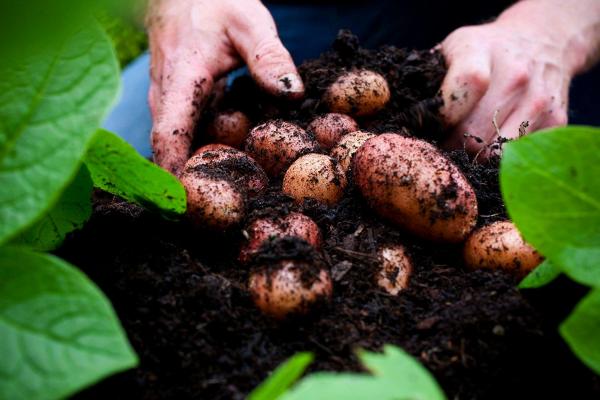Dripping Gardening May 20

Home fries, potato chips, hash browns, and potato salad… does any of that sound good to you?
Potatoes are a staple food for many Americans. They practically go with every meal. There’s nothing wrong with a store-bought spud, but there’s nothing better than an uncommon variety pulled fresh from your own backyard. Don’t be intimidated: growing potatoes is totally worth the effort and gives you so many more options than just the baked Idaho. Nothing against Idaho, but this is Texas and we know a thing or two about spuds too.
You may also think that it is too late in the season to plant potatoes. While I do like to get them in the ground around St Patrick’s Day, I also plant a second run of potatoes in July, which will be here before you know it!
Potatoes come in several colors, shapes, and sizes. They are typically divided by length of growing time – so early, midseason and late types.
• Early Season Potatoes - Early season potatoes mature in 65-80 days. Notable varieties include: Red Gold, which is has red skin and yellow flesh. It has excellent taste but doesn’t store well. It stands up to wet, cold springs to produce yummy potatoes in July. I have had consistent good yields with this variety no matter what spring throws my way. Yukon Gold is another early variety. It has become a popular grocery store variety and for good reason: it’s delicious. But I assure you, homegrown tastes even better. Yukon Golds are susceptible to late blight and have a lower yield.
• Mid-Season Potatoes - Midseason potatoes mature in approximately 80-90 days. Varieties include Adirondack Red which is as blue as a Smurf, through and through. It makes a wonderful July 4th salad when combined with its sister Adirondack Red and a classic white and even maintains its color after cooking! Bred in 2003 at Cornell University, it has an abundance of anthocyanins. These are powerful antioxidants that are healthy for your heart. Another favorite variety is Carola. Carola may well be my favorite potato. It has a wonderful creamy flavor but is nice and firm so holds up in cooking. They are great in stews and on the grill. Carola’s have yellow skin and flesh, are resistant to scab, and have better yields compared to other potatoes I grow. Of course, I cannot fail to mention Kennebec potatoes as they are a classic of the Northeast. They do OK in my garden when protected from late afternoon sun. They are great for baking and store extremely well. Kennebec’s are high yielding and adapt well to various soils.
• Late Season Potatoes - These potatoes take longer than 90 days to mature and are usually good for storing in a root cellar or other cool location, so I really do not grow many. One I do grow is the German Butterball. The German Butterball is large, yellow-fleshed, and on the dry side. Great for baking and roasting, it is known for its high yields and excellent storage qualities. I have also grown the Katahdin potato, which is considered the best storage potato, Katahdin has white waxy flesh, and is adaptable and high yielding.
Another way one can categorize potatoes by type, the six most common are:
• Russet Potatoes – A common, larger potato. They are great for baking and making French fries, mashed potatoes, and hash browns.
• White Potatoes - A medium-sized potato that has a smooth flesh. They are ideal for frying, boiling, steaming, and using in salads. They have a low sugar content with a mild sweet flavor.
• Waxy Potatoes - Yukon Gold and Red Potatoes are examples of waxy potatoes. They hold their shape well, so they are good for boiling, using in soup or chowder, potato salad, and scalloped potatoes.
• Colorful Potatoes - These are less common potatoes that not everyone is as familiar with. Many have a bluish outer skin and purplish inside and are filled with different vitamins in comparison to other potatoes. My favorites are the All-blue, purple Peruvian, and Congo varieties.
• Fingerling Potatoes - Fingerling potatoes are a favorite around our household. I use them in potato salad since they hold their shape well. Fingerling potatoes are small, narrow potatoes that resemble fat fingers. They are popular with chefs because they are sweet and buttery flavored. Fingerlings are very prolific and disease resistant. They are considered late potatoes and do take time to fully mature. Some varieties to try are Austrian Crescent, Banana, and Rose Finn.
• New Potatoes - New potatoes are basically baby potatoes that are harvested in the spring. They’re popular for boiling and using as a side dish because they’re tender and great tasting.
You don’t need seeds to plant potatoes. You just need another potato, so long as it hasn’t been chemically treated. You begin by placing an ample amount of compost and manure in the area where you plan to plant.
Next, you will need to cut up a potato with eyes on it. Slice them up at least a day or two in advance so the potato has a chance to develop a protective coating. This coating helps retain moisture while also protecting the potato from rot. After cutting them up place them in a cool dry area.
Be sure each piece of the potato you are planting has at least two eyes on it and be sure that you plant the potato with the eyes pointing up! Some farmers just bury the whole potato rather than chopping it up because they feel it gives the plant more energy to get off to a strong start. My Great grandmother planted hills of just peeled potato skins any always seemed to get a new batch of taters growing.
Potatoes do best in USDA zones 1-7, but I grow them just fine here in Hays county. Potatoes need full sun, at least 6 or more hours a day but shade in the heat of our summers is beneficial.
As far as soil requirements go, potatoes need loose, sandy, well-draining soil. They want full sun and a slightly acid pH between 5.4 to 5.9. I have heavy clay soil in my yard that is why I grow my potatoes in containers.
If you live in an area without much yard space, then you may already be growing much of your food in containers. I like container gardening because it is condensed and organized. For Potatoes, just pick a container that’s at least 24-inches round and 24-inches deep for each plant.
Drill holes in the base of your container. Place three inches of potting soil at the bottom. Place in two or three seed potatoes or potatoes slices. Next cover with an additional two inches of soil. As your potatoes grow add straw or potting soil around the plants. That’s right, each time your plant shoots up an inch or two of green leaf, just cover them up again with more potting soil or straw. It sounds crazy but it is how you will get your best yield. Harvesting is easy, just dump out the container!


